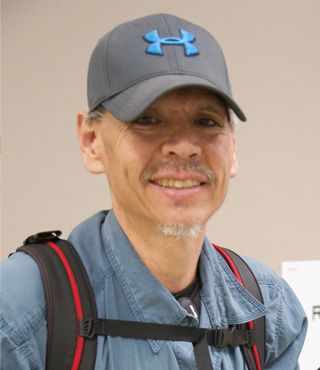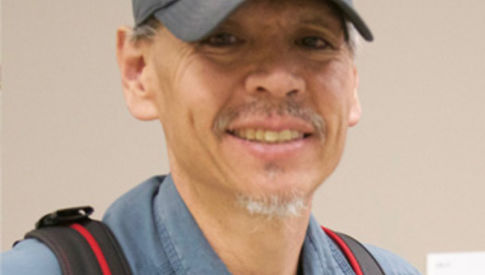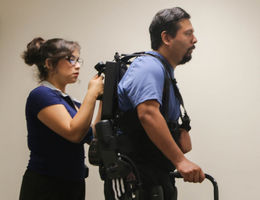We’re Stronger Together
With your help, we can make ambitious innovations in clinical care and education for our community.
Robotic rehabilitation therapy offers hope to patients of all ages suffering from neurological impairment due to stroke, injury or disease (like Parkinson’s). Using advanced robotics, our team helps you reduce pain and improve your ability to move, stand, walk or grasp and manipulate objects.
At the Advanced Neuro Recovery Center, our robotic technology helps you move your body while repeated rehabilitation techniques help retrain your brain. You can see improvements and start to regain your ability to perform everyday tasks as early as your first four visits.


"You get the feeling you’re actually making progress when you can walk again."
We’ll start out by evaluating whether robotic rehabilitation therapy is a good choice for you. If it is, you’ll come to weekly therapy sessions where we’ll help you improve your movement over time.
During your sessions, you’ll perform exercises while assisted by a robotic device. The device is strapped to your body to help you move using the limbs affected by neurological impairment. Each robotic device uses sensors to adapt to your movements.
As you move, the device will either assist or resist your movements to help with your recovery. You’re always the one in control, initiating each movement during exercise tasks. Over time, you’ll be able to safely and properly relearn how to move your body — and we’ll be there to help every step of the way.
Your first visit is free of charge. During the visit, we’ll ask you some questions and take measurements to ensure one of our devices is appropriate for you. If robotic therapy is a good choice for your recovery, we’ll set you up with the device for a trial session. Your trial takes place during the same visit, free of charge.
During the complimentary trial, we test your range of motion and make sure repetitive use of the device won’t cause pain or irritation. If testing goes well, you’ll be approved to use the robotic device during your recovery.
Robotic rehabilitation should not replace conventional therapy. To accelerate your recovery, we recommend you continue conventional therapy at the same time as robotic rehab.
We’ll work with you to understand your goals and determine how many treatment sessions you’ll need to meet those goals. Usually, we recommend four sessions in a block for treatment with one robotic device. Research indicates the greatest progress is made by using robotic therapy three times per week up to 18 sessions. Each session lasts about 45 minutes.
Your treatment plan will include the robotic device best suited to your needs and a number of specialized exercise techniques. Our devices include:
Robotic rehabilitation therapy can give you impactful, long-lasting results. Over many repetitions of specialized exercise tasks, your brain will reorganize itself to help you relearn (known as neuroplasticity). Patients report improved ability to perform everyday tasks up to two years after treatment, including picking up objects and walking around the house. Results can include:
Unfortunately, medical insurance does not cover the cost of robotic therapy. We offer a cash self-pay program.
This is a cash pay program. Please call for up to date pricing.
Eligibility varies for each robotic device. We’ll determine if you’re eligible for a certain device during your complimentary trial.
InMotion ARM Eligibility
Ekso Device Eligibility (In addition to the eligibility requirements listed above)
To get started, fill out the medical clearance paperwork with the doctor referring you for robotic rehabilitation. Please send the completed paperwork to us using one of the following methods:
Once we receive the completed paperwork, we will schedule an appointment for a complimentary trial with one of our robotic specialists. If you have any questions, please call us at 909-558-5879. We look forward to helping you recover with the best possible results.



"You get the feeling you’re actually making progress when you can walk again."
We’ll start out by evaluating whether robotic rehabilitation therapy is a good choice for you. If it is, you’ll come to weekly therapy sessions where we’ll help you improve your movement over time.
During your sessions, you’ll perform exercises while assisted by a robotic device. The device is strapped to your body to help you move using the limbs affected by neurological impairment. Each robotic device uses sensors to adapt to your movements.
As you move, the device will either assist or resist your movements to help with your recovery. You’re always the one in control, initiating each movement during exercise tasks. Over time, you’ll be able to safely and properly relearn how to move your body — and we’ll be there to help every step of the way.
Your first visit is free of charge. During the visit, we’ll ask you some questions and take measurements to ensure one of our devices is appropriate for you. If robotic therapy is a good choice for your recovery, we’ll set you up with the device for a trial session. Your trial takes place during the same visit, free of charge.
During the complimentary trial, we test your range of motion and make sure repetitive use of the device won’t cause pain or irritation. If testing goes well, you’ll be approved to use the robotic device during your recovery.
Robotic rehabilitation should not replace conventional therapy. To accelerate your recovery, we recommend you continue conventional therapy at the same time as robotic rehab.
We’ll work with you to understand your goals and determine how many treatment sessions you’ll need to meet those goals. Usually, we recommend four sessions in a block for treatment with one robotic device. Research indicates the greatest progress is made by using robotic therapy three times per week up to 18 sessions. Each session lasts about 45 minutes.
Your treatment plan will include the robotic device best suited to your needs and a number of specialized exercise techniques. Our devices include:
Robotic rehabilitation therapy can give you impactful, long-lasting results. Over many repetitions of specialized exercise tasks, your brain will reorganize itself to help you relearn (known as neuroplasticity). Patients report improved ability to perform everyday tasks up to two years after treatment, including picking up objects and walking around the house. Results can include:
Unfortunately, medical insurance does not cover the cost of robotic therapy. We offer a cash self-pay program.
This is a cash pay program. Please call for up to date pricing.
Eligibility varies for each robotic device. We’ll determine if you’re eligible for a certain device during your complimentary trial.
InMotion ARM Eligibility
Ekso Device Eligibility (In addition to the eligibility requirements listed above)
To get started, fill out the medical clearance paperwork with the doctor referring you for robotic rehabilitation. Please send the completed paperwork to us using one of the following methods:
Once we receive the completed paperwork, we will schedule an appointment for a complimentary trial with one of our robotic specialists. If you have any questions, please call us at 909-558-5879. We look forward to helping you recover with the best possible results.

With your help, we can make ambitious innovations in clinical care and education for our community.